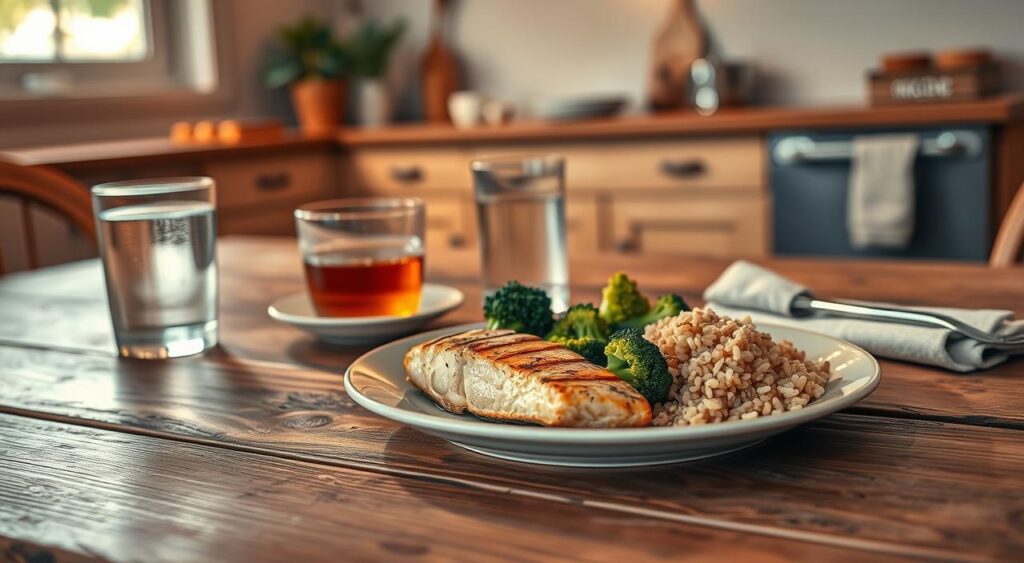Could a single change at dinner help you wake up with more stable glucose levels?
Your evening meals for diabetics can make a big difference. They help prevent morning high readings and night lows. This article offers practical tips to plan dinners that keep glucose steady overnight.
There’s no magic food, but smart combinations matter. Balance carbs with protein, fiber, and healthy fats. Try shrimp or salmon for lean protein, and broccoli and black beans for fiber. Avocados or nuts add healthy fats.
Think of these ingredients as key players in healthy dinner recipes for diabetics. Explore these recipes for inspiration.
Follow the American Diabetes Association’s advice. Personalize meals with your healthcare team. While ADA guidance has changed, many find 45–75 g of carbs per meal helpful. The plate method is also popular.
Next, you’ll find tips on nutrient priorities, cooking methods, and recipes. There are also one-week sample plans, meal prep tips, dining-out advice, and behavior strategies. These will help you create the best dinners for blood sugar control, tailored to your life.
Understanding Diabetes and Meal Timing
Planning your meals can help control your blood sugar levels at night. Eating at the right times can prevent big changes in your blood sugar. This way, you can wake up with more stable numbers and fewer surprises.
Why Evening Meals Matter for Blood Sugar Control
Your body has natural rhythms that affect your blood sugar at night. The dawn phenomenon causes your blood sugar to rise early in the morning. The Somogyi effect can happen after low blood sugar, leading to a high spike.
Choosing the right foods and eating at the right times can help. Tracking your blood sugar at bedtime and when you wake up can guide you. A snack with protein and low carbs might prevent drops in blood sugar.
The Role of Carbohydrates in Your Dinner
Carbs can make your blood sugar rise after dinner. Pairing them with protein, fiber, and healthy fats can slow this rise. The American Diabetes Association suggests finding the right carb amount for you.
Choose carbs with fiber and lower glycemic impact, like whole grains and beans. Avoid foods high in simple sugars. Use the plate method to keep your meals balanced and satisfying.
| Focus | Practical Tip | Why It Helps |
|---|---|---|
| Meal Timing | Finish dinner 2–3 hours before bed or have a light, planned snack | Reduces overnight spikes and prevents late hypoglycemia rebound |
| Carb Choice | Favor whole grains, beans, and fiber-rich fruit | Slows glucose absorption and lowers peak after dinner |
| Protein Pairing | Add lean protein like chicken or salmon to dinner | Blunts post-meal glucose rise and increases satiety |
| Bedtime Snack | Small portion of Greek yogurt or nut butter on whole-grain toast | Stabilizes overnight glucose for those who dip low |
| Monitoring | Use CGM or fingersticks at bedtime and morning for patterns | Guides personalized diabetic meal planning and adjustments |
Key Nutrients for Diabetic-Friendly Dinners
This guide shows you how to make dinner healthy and tasty for diabetics. You’ll learn easy ways to keep your blood sugar stable while enjoying great flavors.
Fiber is key because it slows down how carbs are absorbed. This helps prevent big spikes in blood sugar. There are two types of fiber: soluble and insoluble. Soluble fiber turns into a gel in your gut, slowing digestion. Insoluble fiber adds bulk and makes you feel full.
Include both types of fiber in your dinner. Good sources are black beans, raspberries, broccoli, and whole grains. Try a black bean and quinoa Buddha bowl for a mix of protein, fiber, and texture. Cauliflower “fried rice” is another great option, cutting carbs while adding veggies.
Leafy salads with nuts are also good. They boost fiber and keep you full without adding sugar.
Here are some ways to add more fiber to your dinners:
- Swap white rice for quinoa or barley in bowls and salads.
- Add a cup of roasted broccoli or a side of sautéed spinach to plates.
- Top salads with raspberries or a small handful of walnuts for flavor and fiber.
Healthy fats also play a role in managing blood sugar. They slow down how quickly food leaves your stomach. Choose unsaturated fats from olive oil, avocado, nuts, and fatty fish like salmon. A little goes a long way in adding richness and keeping you full.
Try these ideas for adding healthy fats to your meals:
- Drizzle extra-virgin olive oil over roasted vegetables.
- Add half an avocado to a grain bowl or salad.
- Use a pistachio crust on baked salmon or sprinkle chopped walnuts on greens.
Remember, not all fats are created equal. Avoid saturated fats and high-calorie foods. Balance healthy fats with fiber and lean protein. This way, you can enjoy healthy dinner recipes that help with weight management and blood sugar control.
| Meal Idea | Key Fiber Ingredients | Healthy Fat Source | Why It Works |
|---|---|---|---|
| Black Bean & Quinoa Buddha Bowl | Black beans, quinoa, mixed greens | Avocado slices | Fiber and protein slow absorption; avocado adds unsaturated fat for stable response |
| Cauliflower “Fried Rice” with Veggies | Cauliflower, peas, carrots, scallions | Toasted sesame oil (small amount) | Low-carb base increases veg intake; healthy fat improves satiety |
| Salmon with Roasted Broccoli | Broccoli, kale salad | Pistachio crust or olive oil drizzle | Omega-3s from salmon plus fiber-rich greens support postprandial control |
| Whole Grain Pasta Salad with Veggies | Whole wheat pasta, cherry tomatoes, spinach | Extra-virgin olive oil and chopped walnuts | Whole grains and veggies provide steady carbs; nuts add healthy fats |
Planning Balanced Diabetic Dinners
Good diabetic meal planning starts with simple rules for every night. Use the plate method from the American Diabetes Association. Fill half your plate with non-starchy vegetables, one-quarter with lean protein, and one-quarter with carbs.
Keep carbs around 45–75 grams per meal. Personalize them with help from a dietitian.
Portion Control: Serving Sizes that Work for You
Portion control helps avoid blood sugar spikes and keeps calories in check. Aim for 3–4 ounces of cooked lean meat or fish per serving. If you prefer plant proteins, a 1/2 cup cooked beans provides similar protein with fiber.
For carbs at dinner, a standard is 3/4 cup cooked brown rice or whole-wheat pasta. Use a food scale, measuring cups, or visual cues. A deck of cards equals about 3 ounces of protein. One to two cups of non-starchy vegetables fills half your plate.
If you notice overnight lows, raise the protein or fiber at dinner or add a small high-protein bedtime snack. Work with your healthcare team to match carbs to insulin when needed.
Sample Plate Concepts for Balanced Meals
Try clear, repeatable plate ideas for easy diabetic meal planning. A Teriyaki salmon plate can include 3/4 cup brown rice, 3–4 ounces salmon, and 1 cup steamed broccoli. This mix balances carbs, protein, and fiber.
A Buddha bowl works well for plant-forward nights: 1/2 cup quinoa, 1/2 cup black beans, a large bed of mixed greens, sliced avocado, and pico de gallo. This option supplies fiber, healthy fat, and steady energy.
For minimal starchy carbs, cauliflower fried “rice” with shrimp and mixed vegetables keeps dinner light while providing protein and volume. These are among the best dinners for blood sugar control because they combine low-glycemic carbs, lean protein, and non-starchy vegetables.
You can rotate these concepts to keep variety in your diabetic meal planning. Use the examples above as templates for other meals and adapt portions for your activity level and glucose targets.
| Plate Component | Typical Portion | Common Examples |
|---|---|---|
| Non-starchy Vegetables | 1–2 cups | Broccoli, mixed greens, bell peppers |
| Lean Protein | 3–4 oz (or 1/2 cup beans) | Salmon, chicken breast, tofu, black beans |
| Carbohydrate | 3/4 cup cooked or 1/2 cup for denser grains | Brown rice, whole-wheat pasta, quinoa |
| Healthy Fat (optional) | 1–2 tbsp | Olive oil, avocado, nuts |
Use these sample plate concepts to build more diabetic meal ideas that suit your tastes. Consistent portion control and balanced plates are key to creating the best dinners for blood sugar control over time.
Best Proteins for Dinner Options
Choose proteins that keep your blood sugar steady and your plate satisfying. Opt for lean animal choices and plant-based options. These pair well with vegetables and whole grains. This way, you get many diabetic-friendly dinner ideas and diabetes-friendly dinner options that are easy to prepare on weeknights.
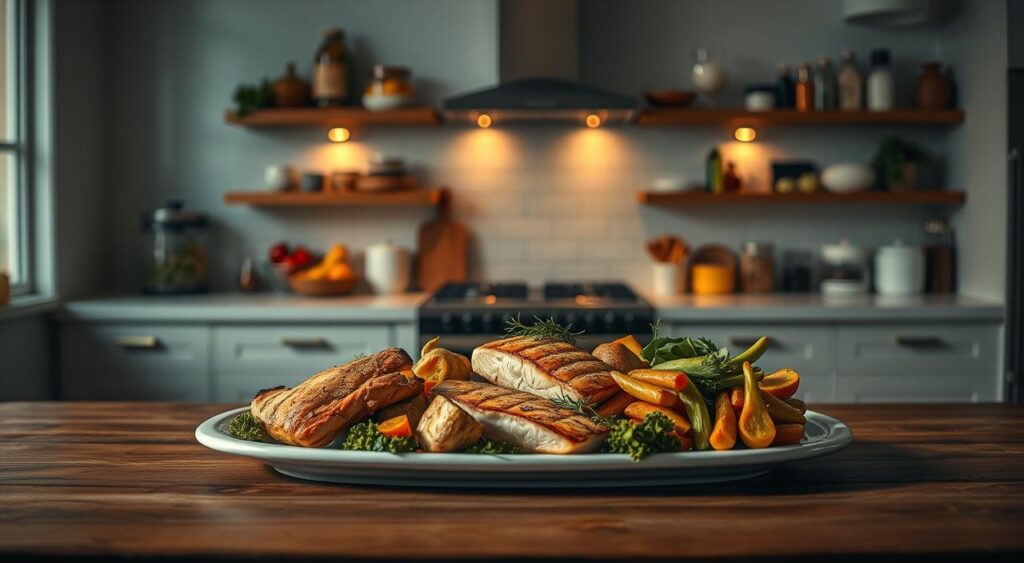
Lean Meats and Alternatives to Consider
Go for skinless chicken breast, turkey, lean pork loin, or lean beef in moderation. Seafood like salmon, shrimp, and canned tuna or salmon make fast, nutrient-dense meals. Try grilled salmon with roasted broccoli or shrimp sautéed with spinach and garlic for quick, healthy dinners.
Plant-Based Proteins and Their Benefits
Beans, lentils, chickpeas, tofu, and tempeh offer protein and fiber. This fiber slows glucose absorption and keeps you full longer. Try a black bean and quinoa bowl or bean patties with a crunchy slaw for diabetes-friendly dinner options that boost fiber.
Pairing plant proteins with whole grains completes amino acid profiles. For example, serve lentils with brown rice or chickpeas with quinoa. These combinations are great for balanced meals that fit a weekly meal plan.
| Protein | Serving Suggestion | Why It Works for Dinner |
|---|---|---|
| Skinless chicken breast | Grilled with lemon and herbs, served with steamed green beans | Low in saturated fat, versatile and quick to cook |
| Salmon | One-pan roasted salmon with broccoli and a squeeze of lime | High in omega-3s, supports heart health and satiety |
| Shrimp | Sautéed with garlic and spinach, served over brown rice | Fast cooking protein, low calorie, pairs well with vegetables |
| Canned tuna or salmon | Mixed into salads or whole-grain wraps | Convenient, budget-friendly source of lean protein |
| Black beans / Chickpeas | Black bean quinoa bowl or roasted chickpeas as a topper | High fiber and plant protein, helps steady glucose |
| Lentils | Lentil stew or lentils over brown rice | Rich in protein and fiber, low glycemic impact |
| Tofu / Tempeh | Marinated and baked, added to vegetable stir-fries | Low saturated fat, adaptable for many flavors |
Whole Grains and Their Benefits
Choosing whole grains for dinner can help manage blood sugar and keep meals satisfying. They are rich in fiber, vitamins, and minerals. These nutrients slow digestion and lower blood sugar spikes compared to refined grains.
Pairing whole grains with lean protein and non-starchy vegetables creates balanced plates. These meals support stable glucose levels overnight.
Opting for Whole Grains Over Refined Options
Swap white rice and refined pasta for brown rice, quinoa, or whole-wheat pasta. These options offer more fiber and nutrients, helping to control blood sugar spikes.
For very low-carb dinners, limit portions and try vegetable substitutes. Use spiralized zucchini instead of pasta, and cauliflower rice for white rice in stir-fries and bowls.
Delicious Whole Grain Recipes for Dinner
Mushroom whole-grain spaghetti with marinara and sautéed mushrooms is a cozy, fiber-rich meal. Keep portions near 3/4 to 1 cup cooked whole grains. Add a salad or steamed broccoli to balance the plate.
Teriyaki salmon with steamed brown rice provides omega-3 fats and a filling base of whole grains. A pasta salad with whole-grain pasta, blanched broccoli, cherry tomatoes, and light vinaigrette is a great make-ahead option.
For low-carb meals, choose whole-wheat or multigrain tortillas. Wrap them with grilled chicken and plenty of greens. These healthy dinner recipes for diabetics help you stay full and in control of carbs.
Portion control is key. Aim for a cooked whole grain serving of roughly 3/4 to 1 cup. Add lean protein and a generous portion of non-starchy vegetables. This will round out the meal and keep blood sugar steady.
Vegetables: The Powerhouses of Nutrition
Vegetables are key for evening meals for diabetics. They provide fiber, vitamins, and are low in carbs. Make them the main part of your plate for balanced blood sugar and fewer calories.
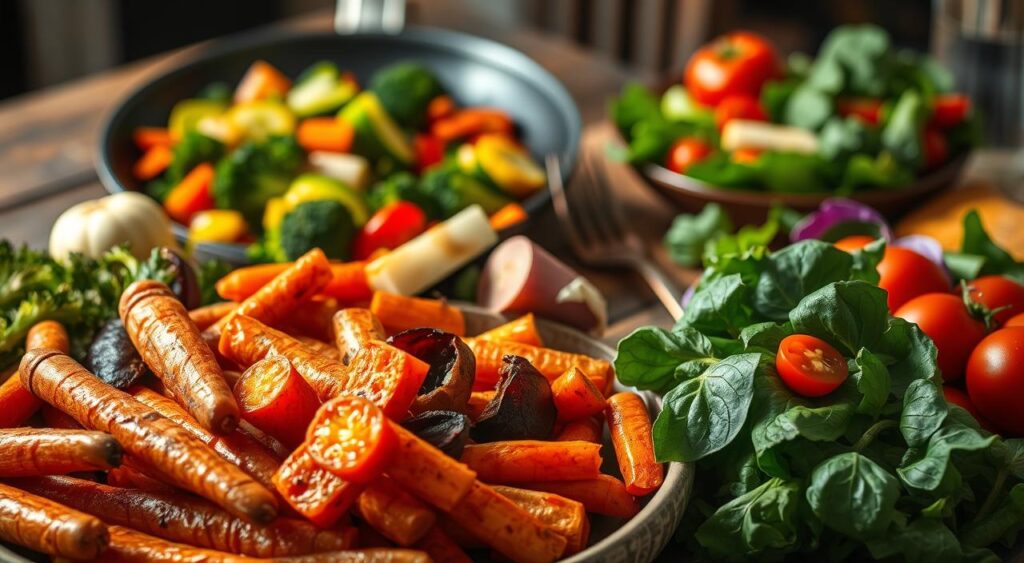
Non-Starchy Vegetables for Blood Sugar Stability
Go for broccoli, spinach, arugula, tomatoes, cucumbers, bell peppers, and leafy greens. They’re low in carbs and calories but rich in fiber and vitamins. Fill half your plate with them to keep your blood sugar stable.
Broccoli is great in salads and as a roasted side. Spinach and arugula are perfect for quick, warm or cold dishes. Cucumbers and tomatoes add freshness without increasing carbs.
Creative Ways to Incorporate More Veggies
Try spiralizing zucchini for zucchini pesto pasta with Cajun shrimp. Or toss spiralized squash into a light sauce. Cauliflower fried rice with mixed veggies is another great swap for rice.
Roast broccoli and mushrooms with balsamic for a one-pan dinner with salmon or chicken. Stir-fry mixed peppers, snap peas, and bok choy with garlic and ginger for colorful sides.
Raw veggies make great snacks or sides. Cucumber and celery sticks with hummus are perfect with grilled fish or turkey. Pickling adds tang and crunch, like pickled jalapeños on canned salmon tostadas.
Vary how you cook veggies to keep meals exciting. Roasting deepens flavors, steaming preserves nutrients, stir-frying makes them crisp-tender, or quick-pickling adds zing. Small changes make diabetes-friendly dinner options enjoyable every night.
Healthy Cooking Methods to Try
Choosing the right cooking methods can make diabetic-friendly dinner ideas tasty and good for your blood sugar. Simple swaps like grilling, baking, or steaming cut added fat and keep meals light. These approaches help preserve nutrients and support weight and insulin goals while delivering flavor.
Grilling, Baking, and Steaming Techniques
Grill shrimp for salads or chicken breasts for a quick weeknight meal. Grilling adds char and depth without extra oil, making quick diabetic dinners satisfying.
Bake a sheet-pan dinner: one-pan roasted salmon with broccoli is fast and low fuss. Broiling fish near the heat source gives you a crisp edge and cooks in minutes.
Steam vegetables to lock in vitamins. Steamed green beans or broccoli pair well with lean protein for balanced diabetic-friendly dinner ideas.
Avoiding Frying for Better Health
Frying raises saturated fat and calories. Swap deep-fried items for baked or grilled versions to lower calorie density and protect heart health.
Use non-stick pans, a light spray, or a teaspoon of extra-virgin olive oil when you need fat for flavor. Toast whole spices like cumin in a dry pan to boost aroma without salt or oil.
For a nutty touch, let cauliflower rice brown undisturbed in the pan. That simple move turns a side into a satisfying base for quick diabetic dinners and keeps your meal plan varied.
Flavoring Your Dinners: Choosing Wisely
Good flavor makes it easier to stick with healthy habits. You can lift simple, diabetes-friendly dinner ideas by using herbs, spices, citrus, and low-sodium swaps. These choices keep meals vibrant without adding extra sugar or salt, so your evenings can taste great while supporting steady glucose.
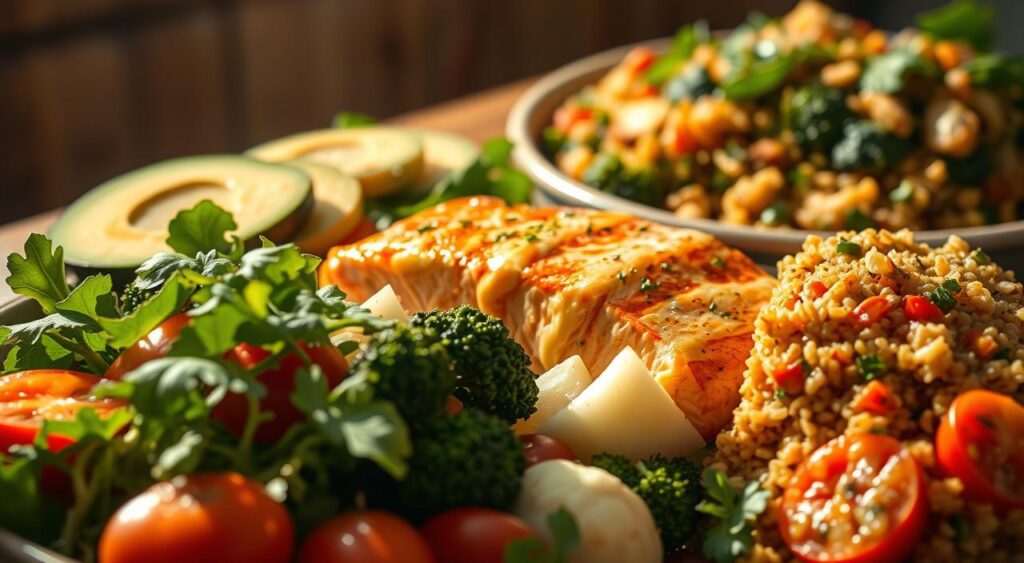
Herbs and Spices That Can Help
Start with garlic, parsley, and cilantro to build fresh notes in salads, fish, and grain bowls. Toast cumin briefly in a dry pan to bring out its aroma for roasted vegetables or chickpea salads.
Cinnamon adds warmth and can modestly affect postprandial glucose when used on oats or yogurt bowls. Use crushed red pepper sparingly to give shrimp or vegetable dishes a lively kick without sodium.
Use lemon zest and lemon juice to brighten flavors in place of sugary sauces. EatingWell style combos—lemon, parsley, cilantro, and crushed red pepper—work well with shrimp, tossed greens, or roasted squash.
Low-Sodium Alternatives for Better Flavor
Swap high-sodium bottled sauces for homemade light vinaigrettes made from olive oil, vinegar, and herbs. Reduced-sodium broths keep soups and stews savory without overwhelming salt.
Replace sour cream with an avocado crema blended with cilantro and lime for tacos and bowls. Salsa or pico de gallo add fresh acidity and texture to proteins and roasted veggies.
Be cautious with teriyaki and store-bought marinades; many contain both sodium and sugar. Either choose low-sodium versions or make simple marinades using soy sauce substitute, rice vinegar, garlic, and ginger.
| Flavoring Option | Best Uses | Benefits for Blood Sugar |
|---|---|---|
| Garlic, Parsley, Cilantro | Salads, grilled fish, grain bowls | Adds flavor without sugar or salt; increases meal satisfaction |
| Toasted Cumin | Roasted vegetables, salads, legumes | Boosts aroma so you use less salt; pairs well with fiber-rich foods |
| Cinnamon | Oats, yogurt, baked fruit | May modestly reduce post-meal glucose; adds sweet flavor without sugar |
| Crushed Red Pepper | Shrimp, vegetable sautés, sauces | Enhances taste with minimal calories or sodium |
| Lemon Zest & Juice | Fish, salads, vinaigrettes | Brightens dishes; replaces sugary dressings and high-sodium sauces |
| Avocado Crema | Tacos, bowls, roasted vegetables | Healthy fats and flavor replace sour cream, aiding satiety |
| Homemade Vinaigrette | Green salads, grain salads, marinades | Controls sodium and sugar; versatile for diabetes-friendly dinner options |
| Salsa / Pico de Gallo | Bowls, grilled proteins, eggs | Fresh flavor, low in sodium and sugar; pairs with fiber-rich sides |
Trying these techniques helps you build the best dinners for blood sugar control while keeping meals enjoyable. Small swaps make diabetes-friendly dinner options feel more like treats than restrictions.
Meal Prep Ideas for Busy Weeknights
Weeknights can get hectic, but simple meal prep keeps things calm. Batch-cook ingredients that can be mixed and matched all week. This approach saves time and ensures you always have healthy dinner options.
Quick Make-Ahead Dinner Recipes
Cauliflower fried rice with shrimp and broccoli is a quick, low-carb meal ready in 25 minutes. Shrimp with spinach and garlic is another fast option, packed with protein and iron. Roasted salmon and broccoli is great for reheating and can be used in salads or wraps.
Bake extra salmon or chicken for future meals. Cook whole grains like farro or brown rice and store them in the fridge for 3–4 days. Mason jar salads or Buddha bowls keep your meals fresh and easy to prepare.
Time-Saving Tips for Preparing Diabetic Meals
Roast a tray of mixed vegetables on Sunday for use in various meals all week. Freeze cooked grains in individual portions for quick meals. Canned low-sodium beans add protein and fiber to your dishes.
Use frozen vegetables to save time and reduce waste. A slow cooker or Instant Pot can cook tougher meats and beans while you’re busy. Roast chickpeas for a crunchy snack and portion nuts or seeds for overnight hunger.
Keep a list of staples like salmon, shrimp, spinach, cauliflower, brown rice, and low-sodium beans. This focused list helps with consistent meal planning and ensures you always have quick, healthy dinner options.
Sample Evening Meal Plans
Plan dinners that keep blood sugar steady and taste great. This one-week diabetic meal plan balances protein, fiber, and whole grains. It helps you pick meals that fit your carb target and family schedule.
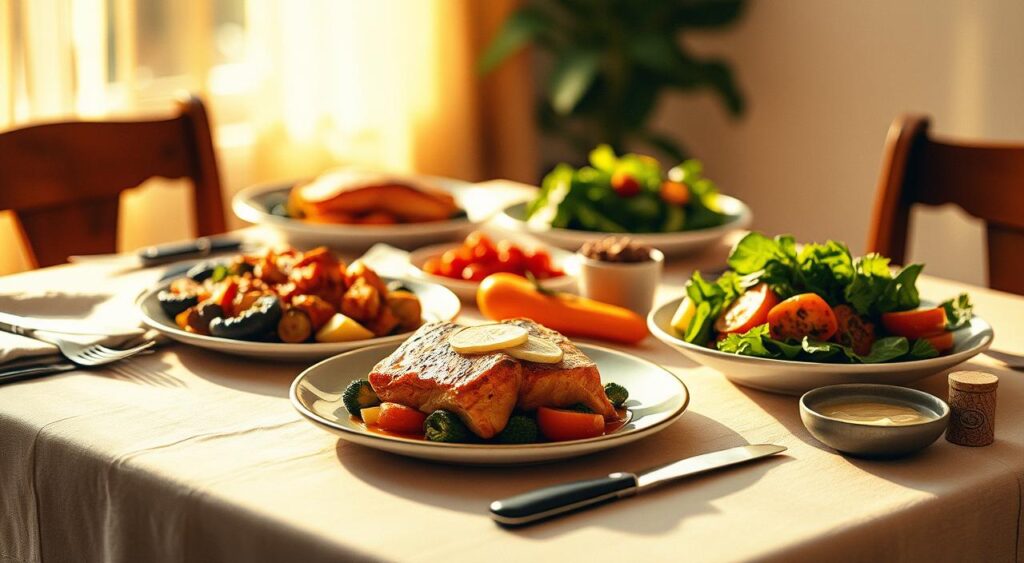
One-Week Plan for Diabetic-Friendly Dinners
Monday: Roasted salmon with a lemony pistachio crust, 3/4 cup brown rice, and roasted broccoli. This meal offers healthy fats and fiber without too many carbs.
Tuesday: Cauliflower fried “rice” with shrimp, bell peppers, and garlic. It’s a low-carb option that’s quick to make on busy nights.
Wednesday: Black bean and quinoa Buddha bowl with pico de gallo and sliced avocado. It’s a plant-forward choice with steady-release carbs.
Thursday: Teriyaki salmon with a light sauce, 3/4 cup steamed brown rice, and steamed greens. Keep sauce portions small to control sugar.
Friday: Black bean patties with creamy slaw and a crisp side salad. Swap in ground turkey if you prefer a meat option.
Saturday: Shrimp tacos with avocado crema on whole-grain or low-carb tortillas and mixed greens. Let kids pick toppings to make it family-friendly.
Sunday: Vegetarian salsa chili or a turkey version, served with small whole-grain crackers or brown rice. Warm bowls are filling and easy to portion.
Family-Friendly Options that Everyone Will Enjoy
Scale portions for kids and adults. Add a modest serving of whole-grain pasta or rice for younger eaters. Swap proteins like fish, turkey, or plant-based options to fit tastes. Present colorful salads and veggie sides to boost appeal.
For carb balancing, include one to two servings of whole grains or starch per dinner. On lower-carb nights, emphasize extra non-starchy vegetables and a bit more protein.
If you need a bedtime snack, choose a handful of nuts, a hard-boiled egg, or low-fat cheese with whole-wheat crackers. These small choices can protect you from nocturnal hypoglycemia without spiking glucose.
Enjoying Dinner Out: Choosing Wisely
Eating out can be tricky when you manage blood sugar. But, making simple choices makes it stress-free. Look for cooking methods and sides that balance your meal. Use the plate method: half vegetables, a quarter lean protein, a quarter starch.
Reading Menus for Healthy Options
Choose entrées that are grilled, baked, steamed, or broiled. These have less fat than fried or creamy dishes. Opt for lean proteins like salmon, shrimp, chicken breast, or turkey.
Ask if they have brown rice or whole-grain pasta. Swap fries or mashed potatoes for a side salad or extra veggies. Also, ask for sauces and dressings on the side to control portions and sugars.
Making Requests That Support Your Health
Special requests help you enjoy healthy meals without hassle. Ask for sauces with less sodium or no added sugars. Swap high-carb sides for steamed veggies or a simple salad.
Control portions by asking for a half-portion or boxing half your meal at the start. For tacos or bowls, add extra veggies and a light topping instead of sour cream.
Order wisely. Choose a grilled salmon with steamed veggies, or shrimp with a side salad and brown rice. These choices keep your meals balanced and help control glucose overnight.
Tips for Maintaining Steady Blood Sugar Levels
To keep your blood sugar stable at night, plan ahead and follow daily habits. Use diabetic meal planning to match carbs with your medication or insulin. This helps avoid sudden changes in blood sugar while you sleep.
The Importance of Eating at Regular Intervals
Eating at the same times each day helps control blood sugar. Stick to a routine for meals and snacks. This way, you can match your carb intake with your medication.
Pairing carbs with protein and fiber slows down blood sugar rise. This keeps it steady. Test your glucose at bedtime and when you wake up if you notice problems.
Continuous glucose monitors like Dexcom or Abbott FreeStyle Libre can show patterns. Use these insights to adjust your evening meals. Talk to a registered dietitian for personalized advice.
Hydration: Don’t Forget Your Fluids
Drinking water helps keep blood sugar levels normal. Aim for regular water intake throughout the day. If you wake up thirsty, drink water in the evening.
Stay away from sugary drinks and limit alcohol at night. They can cause low blood sugar later, if you take insulin or sulfonylureas.
A small, high-protein snack before bed can be helpful. Try a handful of almonds, a hard-boiled egg, or a slice of low-fat cheese with a whole-wheat cracker. These snacks provide protein without too many carbs.
When planning dinners, choose meals that control blood sugar well. Use diabetic meal planning to create meals that fit your routine and medication. Consistent timing, smart hydration, and thoughtful snacks are key to a good night’s sleep.
Common Mistakes to Avoid
Dinner choices affect your glucose levels and energy the next day. Be careful of hidden traps to enjoy meals without setbacks. Making small changes and staying aware can help you stick to better diabetic meal plans that fit your life.
Pitfalls to Watch Out for During Dinner
Big portions of rice, pasta, or mashed potatoes can increase carbs more than you think. Large starchy sides can ruin your careful planning and make blood sugar control harder.
Heavy creamy sauces and fried foods add calories and slow digestion. This can lead to overeating and make weight management harder over time.
- Restaurant meals often have more carbs than listed. Ask for portions to be split or for sauces on the side.
- Pre-made convenience items may seem easy, but serving sizes and hidden ingredients raise your carb load.
- Mindless finishing of the plate is common. Pause between bites and check your fullness.
Understanding the Impact of Hidden Sugars
Bottled sauces like teriyaki and barbecue often contain added sweeteners and high sodium. Store-bought salsas, marinades, and flavored yogurts can hide sugar where you least expect it.
Read labels for total carbs and added sugars. If a product lists sugar near the top of ingredients, choose a lower-sugar version or make it at home.
- Make sauces and dressings with fresh herbs, citrus juice, olive oil, and a touch of mustard.
- Swap flavored condiments for plain Greek yogurt or mashed avocado to cut added sugars and boost protein.
- Choose whole-food carbs like beans and quinoa for steady glucose and lasting fullness.
Avoid common diabetic dinner mistakes by planning and following simple swaps. Use these tips to refine your diabetic meal ideas and reduce the chance of hidden sugars in dinner derailing your progress.
How to Make Your Dinner More Enjoyable
Make your evening calm and healthy eating fun. Turn off phones and dim lights. Serve meals on colorful plates to make each bite special. Mindful eating lets you enjoy flavors and feel full.
Creating a Positive Dining Atmosphere
Begin with small rituals. Play soft music, light a candle, or share something good from your day. These actions help you enjoy meals without distractions.
Plan dinners early to avoid stress and make better choices. The American Diabetes Association recommends mindful eating and simple meal plans. This way, you’re more likely to pick enjoyable diabetic dinners that keep blood sugar steady.
Use portioned bowls for everyone to serve themselves. This helps keep portions right and encourages talking over eating.
Encouraging Family Involvement in Cooking
Get family to help with meal prep. Kids can wash veggies, teens can mix dressings, and adults can grill. Everyone gets involved and excited to try new foods.
Set up stations for customizable meals. Offer whole-grain sides, a bit of rice, colorful veggies, salsas, and avocado. Let everyone create their own plate with their favorite toppings.
Try theme nights like Mexican bowls or seafood. Use different herbs, spices, and grains like farro and quinoa. This keeps dinners exciting and fresh.
Keep a list of favorite recipes to try each week. Options like shrimp tacos, baked salmon, and bean patties please everyone. When family helps make the meal, they’re more open to trying new things.
Conclusion: Making Diabetic Dinners Delicious and Fulfilling
For a great evening meal, aim for a balanced plate. Include non-starchy veggies, lean proteins, whole grains, and healthy fats. These foods help keep your blood sugar stable overnight.
Start by adding more veggies, using cauliflower rice, or choosing grilled proteins. See how your body reacts. This makes meal planning easier and more enjoyable.
Monitor your blood sugar after dinner and snacks. This helps you adjust your meals to fit your needs. Work with your healthcare team to set the right carb targets and timing.
Choose low-carb dinners that are tasty and easy to make. Try batch-cooking and quick snacks like nuts, hard-boiled eggs, or low-fat cheese. This helps avoid blood sugar spikes at night.
Don’t forget to keep your meals interesting and flavorful. Use resources like EatingWell for recipe ideas. Follow the American Diabetes Association’s plate-based examples for meals that are good for the whole family.
Stay excited about your meals by focusing on taste and making small changes. When you make meal planning a habit, you keep your blood sugar stable and enjoy meals that are good for you.

